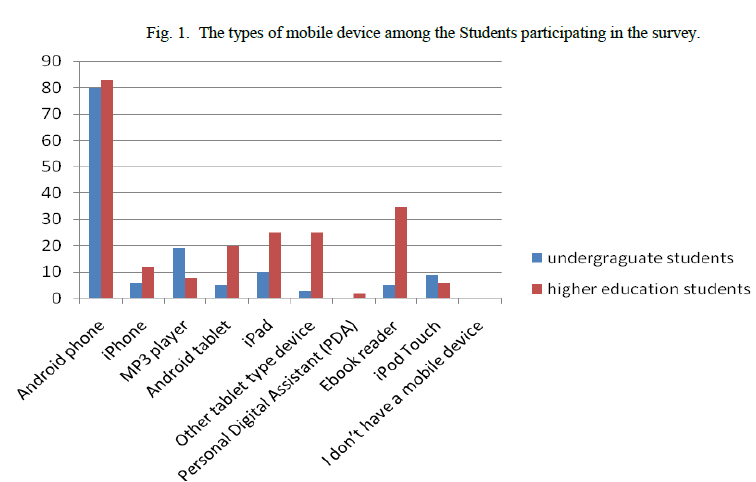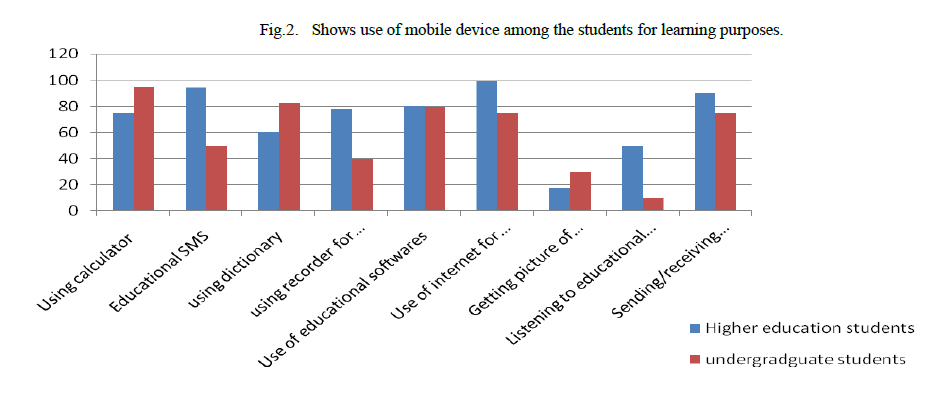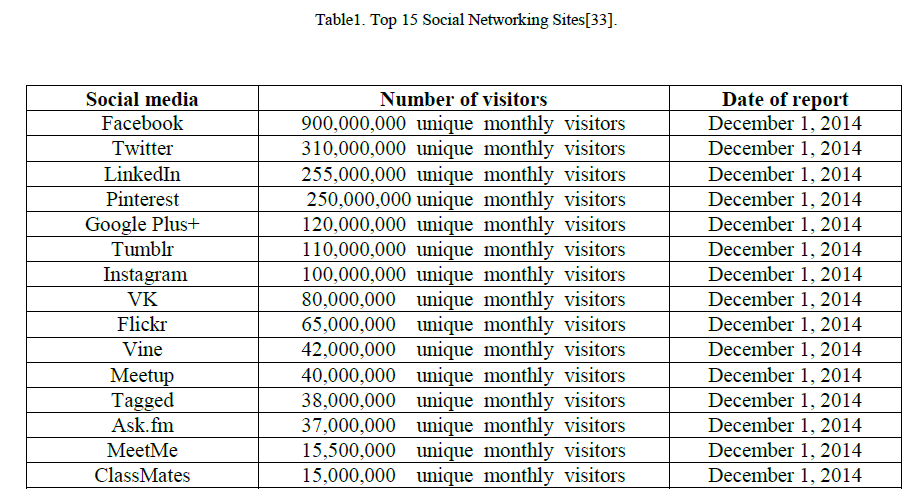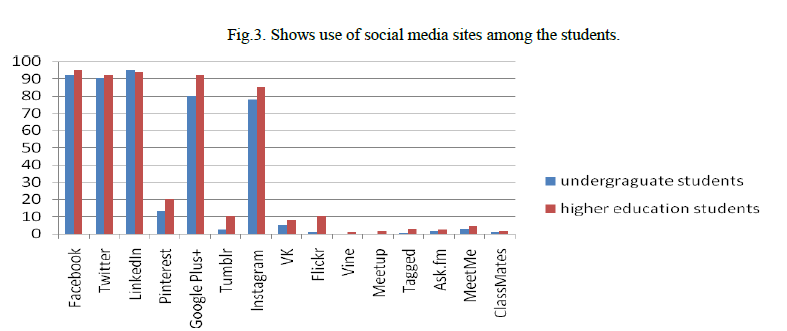ISSN ONLINE(2320-9801) PRINT (2320-9798)
ISSN ONLINE(2320-9801) PRINT (2320-9798)
| Ammar Khader Mohammad Almasri Department of MIS, Albalqa Applied University, Jordan, Amman |
| Related article at Pubmed, Scholar Google |
Visit for more related articles at International Journal of Innovative Research in Computer and Communication Engineering
Mobile learning (M-learning) creates a new channel for learning, but the students' readiness to use mobile phones in learning process is still in the early stages. This study is aimed to better understand how undergraduate and higher education students use mobile technology for learning purpose. A total of 400 students in Amman University College participated in the study, where this study consisted of 200 undergraduate students and 200 higher education students. During the survey, a questionnaire was distributed to collect the needed data. The purpose of the survey was to investigate; (1) Ownership of mobile devices by Amman College students; (2) usage of mobile devices among the students for learning purposes and (3) usage of social media sites. The results indicate that the majority of the participants currently own and use phones, particularly android devices and iPhone for academic purpose. Most of higher education and undergraduate students already have social media applications specially Facebook account
Keywords |
| M-learning, Readiness, HES, Social media |
INTRODUCTION |
| According to [1] ,With the development of digital technique, the upgrade of mobile devices rate, the drop in the price of mobile devices , the improvement in the computing performance and storage capacity of the handheld mobile devices (such as cell phones, PDA, etc.), and increase in the number of mobile devices led researchers to focus on using these devices as a medium of learning [2].These mobile devices integrate a series of features and capabilities such as making phone calls, recording audio/video, capturing pictures, storing data, the use of Short Message Services (SMS), Wi-Fi, GPS, and accessing the Internet [3]. All of these functionalities can be used in various learning environments [4]. |
| Despite these advantages there are some limitations that create a challenge for M-learning. Furthermore, The first of them is concerning with the limitations that these devices have in features when compared with laptop and desktop computers[23- 28],naming the screen size, performance and memory space among others [29].Supporting efficient data access in the mobile learning environment is becoming a hot research problem in recent years, and the problem becomes tougher when the clients are using mobile devices [11]. These challenges may be inclined for some students to avoid using M-learning [30]. In addition, adoption and implementation of M-learning are significant issues for universities [31].Moreover, This study will focus on the increasing number of students who will use M-learning, especially with undergraduate and higher education students by exploring their readiness to use mobile phone in learning process. Finally, the outcomes of this study are likely to be useful for the developers and designers of M-learning; to increase the number of undergraduate and higher education students whom will use their mobile device in learning. |
II. MOBILE DEVICE AND INTERNET IN JORDAN |
| According to the Ministry of Communications and Information Technology in collaboration with the Department of Statistics Survey reports; that the use of information and communications technology at private residence in 2013, has risen in the proportion of Households that have Internet available in homes where amounted to about 57% compared with 47% in 2012, which shows the evolution in the levels of competition taking place in the Internet market, which led to the increase Rates of broadband internet penetration in all regions of the Kingdom. The results of the survey showed that Internet service via mobile phone Presentation Ad-scale Mobile Broadband is the most commonly used method to connect to the Internet, reaching nearly 78%, followed by communication service Wap GPRS through and amounted to about 27%, followed by third place Wi max 10.4%[32].According to the IT department of Amman University College, there is free Wi-Fi almost everywhere on campus as well, but it is usually very slow and frequently unreliable due to the amount of users. |
III. METHODOLOGY |
| This study used a random sampling technique to collect data between higher and undergraduate students in Amman University College located in Amman, Jordan. The participants in this study were 200 undergraduate students and 200 higher education students. Questionnaires were distributed during the first semester in 2014 to different majored students. |
IV. RESULTS AND DISCUSSION |
A. Ownership of mobile devices by Amman College students |
| Among the participants, 80% of undergraduate and 83% of higher education students had an android phone. All the participants own and use mobile phones, moreover most of them own an Android phone, while a small number were using other types of devices. To influence students to use M-learning, instructors and the IT department at Amman College need to be more familiar with Android as well as building their applications in learning process (figure1). |
 |
B. Using of mobile device among the students for learning purposes |
| Our results indicated that, among the students who had access to mobile devices, more than half reported that they used them for academic purposes. As figure 2 shows, 75 percent of higher education students said they used the device for using calculator, while 95 percent of undergraduate students. The results also revealed that 94 percent of higher education students used their mobile device for sending educational SMS, while undergraduate students were 50 percent. 60% of higher education students and 82.5 % of undergraduate students are more likely to use dictionary. |
| The results of data analysis also indicated that 78% of higher education students were more frequently using recorder for presentations class and a few of undergraduate students (40%). A great majority of higher education students stated that they used email (90%), Listening to educational material (50%), Getting picture of educational material (17.5%) ,and Use of educational software (80%) ,while the results for undergraduate indicated as follows: (75%) used email, Listening to educational material (10%), Getting picture of educational material (30%) ,and Use of educational software (79.5%).Use of internet for educational material is the most preferred option for mobile device usage among students, where it was 99% of higher education students and 75 % of undergraduate students. |
 |
C. . Using social media sites |
| There have been many of growth in social media websites recently. This growth is referred for various reasons like invest in companies or build a better brand awareness. In any case, here we present the Top 15 social media statistics from the year 2014 that show in table 1. |
 |
| Based on the table 1, the results of descriptive analysis for social media usage by both undergraduate and higher education students indicated that a significant portion of undergraduate and higher education students currently use Facebook ,Twitter, Google Plus+, and Instagram , compared to other social networking sites which registered less frequent use by undergraduate and higher education students. Based on the results that shown above, most of higher education and undergraduate students already have social media applications specially Facebook account. In order to increase students’ attitude to use mobile device in learning process , social media should be considered as an essential tool in learning process to access their courses by using mobile devices. Influence students to use of M-learning, instructors at Amman College need to be more familiar with social media as well as using their mobile devices in learning process. The findings of this study should help in the design of more user-accepted M-learning systems. |
 |
V. CONCLUSION |
| This paper has given an overview of the level of implementation of mobile learning in Amman University College. This study aimed to assess the readiness among graduate and higher education student for mobile learning. The results indicate that the participants own and use phones for academic purpose. Most of higher education and undergraduate students already have social media applications. |
| This study has some limitations; the sample included undergraduate and higher education students at only one college in Amman-Jordan. Future research could focus on varied contexts or samples; also while the survey provides data regarding mobile usage for students only, it does not speak to the instructor. Further research could be designed and conducted to measure instructor readiness for M-learning. |
References |
|